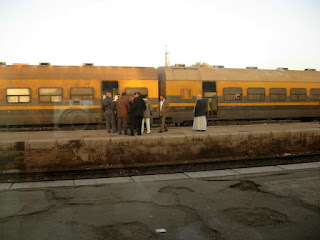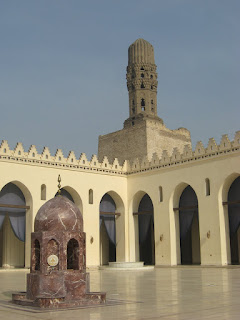We had boarded the train in Aswan yesterday evening for the overnight trip all the way north to Cairo. We were served a dinner as we rumbled north, and entertained ourselves writing our journals and reading our Nooks, before making up the upper and lower bunks and going to bed.
Dalia told us yesterday to be prepared – there might be some changes to our schedule. She had received a couple dozen text messages alerting her to demonstrations in
We wake up at sunrise, around 5:30, to find the train stopped. The train stops and resumes moving several times during the morning and our scheduled 7 am arrival is delayed until 9:30.
Officials were waiting to see how the street demonstrations in Cairo Giza , on the west side of the Nile, across the river from Cairo.
There are thousands protesting in the streets of Cairo, we are told, inspired by the Tunisian uprising. We have the impression the police are caught by surprise. We understand Samir is out demonstrating. People want change, want to be heard, want police reform. Using radical Islamic movements as an excuse, the entire country has been under martial law for more than 30 years. Police and other security forces are excessive in their use of force. They arrest and detain people for weeks and sometimes people simply disappear. There is no due process, nothing like a bill of rights. There’s also a stifling bureaucracy and a sense that there is corruption everywhere. These are complaints we have heard over the last two weeks, and what we have seen seems to confirm their validity.
 |
A local train at a station not far out of Cairo
|
There are thousands protesting in the streets of Cairo, we are told, inspired by the Tunisian uprising. We have the impression the police are caught by surprise. We understand Samir is out demonstrating. People want change, want to be heard, want police reform. Using radical Islamic movements as an excuse, the entire country has been under martial law for more than 30 years. Police and other security forces are excessive in their use of force. They arrest and detain people for weeks and sometimes people simply disappear. There is no due process, nothing like a bill of rights. There’s also a stifling bureaucracy and a sense that there is corruption everywhere. These are complaints we have heard over the last two weeks, and what we have seen seems to confirm their validity.
Dalia meets us at the train station. She has scoped out the situation, calling and texting her friends around town and we decide to proceed with our tour of Islamic medieval Cairo Cairo, probably
People have informally arranged a entire city infrastructure there with electricity, running water, waste disposal – it’s not a shanty town – it’s houses, constructed within and making use of the elaborate tomb structures.

People have informally arranged a entire city infrastructure there with electricity, running water, waste disposal – it’s not a shanty town – it’s houses, constructed within and making use of the elaborate tomb structures.

We also drive by Saladin’s walled citadel on the high ground in Cairo
We spend three hours on foot touring through many mosques, madrassas and kitab schools, palaces and a cistern that reminds us of the great Istanbul
An Indian film crew wants to interview us about our impressions of the mosques – Jim declines (in retrospect, we wonder what they may have filmed during the next two weeks).
 |
| Beautifully delicate designs in stone |
An Indian film crew wants to interview us about our impressions of the mosques – Jim declines (in retrospect, we wonder what they may have filmed during the next two weeks).
 |
| An "incense burner" minaret dating to 1303, at the Al-Hakim Mosque |
The Al-Hakim Mosque, named after the Fatimid Caliph Al-Hakim, is one of a few Fatimid-era buildings in Cairo. It was erected in 1013 AD., and in 1303, after an earthquake two "incense-burner" minarets were added. (No, they were never used to burn incense but they are called that because of their resemblance to incense burners.) The courtyard seen in the picture above is part of restoration project in 1981, which added the marble and other non-original materials to the mosque.
We also visit the 19th century Suleyman Aga El-Silahdar Mosque with its Sabil (pubic water fountain), and the Ottoman era House of al-Suhaymi. This house was built around 1650 and added on to for another 150 years, providing living space for all of the harem ladies and their children.
In includes a lovely green open courtyard, designed to provide a cool refuge from Cairo's summer heat. The room below would allow the ladies of the house to look out and see what was happening on the street, but the clever window shield them from public view.
Below is a view of the windows from the street.
 |
| Glorious ceiling |
 |
| Another ceiling |
Th artistry in stone, tile and inlaid wood is delightful, and very typical of Islamic art through the centuries.
We walk to a corner of the famous Khan Al Khalili Bazaar, look at a few shops that have fixed (and very fair) prices and pick up a few things we especially liked, planning to return for much more shopping in the big bazaar on our last day before our departure from Egypt. (We never got back.) We doubt it would have equaled the Grand Bazaar of Istanbul, but it is reputed to be wonderful, with many uniquely Egyptian wares. Another "must see" for our next trip to Egypt.
Our plans for the day had included a tour of Coptic Cairo this day too, but because of the lateness of our arrival in the morning and the growing protests, Dalia decides this needs to be missed. She is in regular contact with others around the city and says she wants us back in our room at the Talisman (the same hotel where we had stayed on our arrival in the city) before people get out of prayers a little after 4.
Dalia stops at her favorite take-out place in Cairo
We check back in to the Talisman and meet Samir in person for the first time. We both immediately like him – a very impressive man, tall (at least 6’ 4”, handsome and confident). We how delighted we are with the tour that Dalia provided – we are so happy that she has been our guide.
Samir says he believes we will be safe, but worst case we can evacuate to his home which is near the airport (if we can stand his two little kids!- that would have been fun!). We appreciate that there is a plan B. There is a big demonstration called for 8 pm tonight and no one knows what’s going to happen.
We check back in to the Talisman and meet Samir in person for the first time. We both immediately like him – a very impressive man, tall (at least 6’ 4”, handsome and confident). We how delighted we are with the tour that Dalia provided – we are so happy that she has been our guide.
Samir says he believes we will be safe, but worst case we can evacuate to his home which is near the airport (if we can stand his two little kids!- that would have been fun!). We appreciate that there is a plan B. There is a big demonstration called for 8 pm tonight and no one knows what’s going to happen.
We take an afternoon nap and set ourselves up for action if necessary. Bags packed, clothes handy, passports handy, ready for a quick exit and stay alert.
The evening demonstration begins , peacefully and we look out from our balcony which overlooks an intersection, one block from the Supreme Court building and not far from Tahrir Square
We hear concussions and see a cloud of spreading tear gas on the corner by the hotel. There had been maybe 150 people moving by chanting loudly, and after the tear gas, we hear shouting and see people - and the pigeons on the rooftop - fleeing . More paddy wagons arrive on our corner, lights flashing, park there briefly and then move on. Things quiet down by 10 or so. Jim stays awake, reading and watchful until about 11:30.
more pictures here: https://picasaweb.google.com/eloise.hedbor/20110126?authkey=Gv1sRgCJiRj_WzmrXQjgE#
 |
| From our bedroom window |
We hear concussions and see a cloud of spreading tear gas on the corner by the hotel. There had been maybe 150 people moving by chanting loudly, and after the tear gas, we hear shouting and see people - and the pigeons on the rooftop - fleeing . More paddy wagons arrive on our corner, lights flashing, park there briefly and then move on. Things quiet down by 10 or so. Jim stays awake, reading and watchful until about 11:30.
more pictures here: https://picasaweb.google.com/eloise.hedbor/20110126?authkey=Gv1sRgCJiRj_WzmrXQjgE#





No comments:
Post a Comment